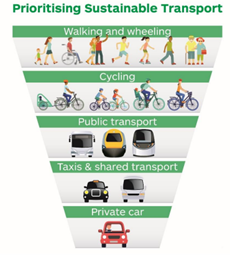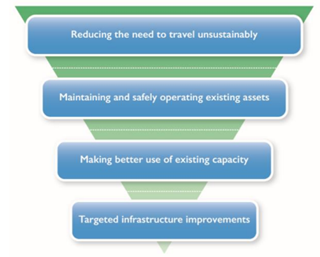Introduction
This paper provides a broad framework for both understanding and illustrating how the transport sector supports and improves our daily lives, and how it contributes to growing our economy.
Initially the paper introduces the National Transport Strategy (NTS) – Transport Scotland’s overall framework for shaping strategic decisions about transport interventions.
It then moves on to focus on a brief economic history – how we got where we are today. The paper transitions to a conceptual model to trace the impacts of the transport network on Scotland’s economy. By its nature, this is both high level and illustrative. After all, the transport sector will touch everyone in Scotland’s life every single day – whether because we are travelling ourselves or because we rely on the transport network to facilitate events, deliver goods and services, etc. Indeed, it is all but impossible to imagine a functioning economy and society without a functioning transport network.
The paper moves on to look at some more applied examples of how transport supports the economy. Economic case studies are given to illustrate the economic footprint of the sector itself, as well as a more theoretical discussion of agglomeration and how transport can help boost productivity. Reflecting a focus on the economy beyond headline economic measure, the role of transport in terms of health, safety and wellbeing is discussed. Acknowledging that addressing inequalities is a key part of improving economic outcomes (and vice versa), the paper goes on to explore other key elements of the socio-economic role of transport. This is explored via the lens of access to different modes of transport, and both elements are explored in terms of the role of transport in overcoming geographical challenges. Of course, an important cornerstone of economic policy over the longer term is facilitating a just transition and de-carbonising the economy. The paper also discusses the opportunities and at times the challenges that this poses in a transport context.
The paper then shifts to focus more on the role of Transport Scotland. While transport has a huge role to play in delivering a more prosperous and fairer economy, it is vital to recognise and consider the challenges faced. A clear constraint is the scale of the fiscal challenge facing us. The paper looks both at the funding available and the pressures faced by the sector in terms of the impact of the pandemic and of anticipated demographic changes.
Finally, the paper concludes by looking at how Transport Scotland is addressing these concerns at a strategic level. Clearly some form of trade-off is required when considering these issues and the wider factors involved, and so the paper offers a brief overview of how Transport Scotland works to deliver our National Transport Strategy, highlighting it’s role in guiding policy and investment decisions.
National Transport Strategy
Scotland’s National Transport Strategy (2), referred to here as NTS2 and published in February 2020, sets out an ambitious vision for Scotland’s transport system for the next 20 years as well as the strategic framework for delivering on that vision. The vision is to have a sustainable, inclusive, safe and accessible transport system, helping deliver a healthier, fairer and more prosperous Scotland for communities, businesses and visitors. It is underpinned by four interconnected priorities: reduces inequalities, takes climate action, helps deliver inclusive economic growth and improves our health and wellbeing.
Figure 1.1 - The NTS2
Our Vision
We will have a sustainable, inclusive, safe and accessible transport system, helping deliver a healthier, fairer and more prosperous Scotland for communities, businesses and visitors.
Reduces inequalities
- Will provide fair access to services we need
- Will be easy to use for all
- Will be affordable to all
Takes climate action
- Will help deliver our net-zero target
- Will adapt to the effects of climate change
- Will promote greener, cleaner choices
Helps deliver inclusive economic growth
- Will get people and goods where they need to get to
- Will be reliable, efficient and high quality
- Will use beneficial innovation
Improves our health and wellbeing
- Will be safe and secure for all
- Will enable us to make healthy travel choices
- Will help make our communities great places to live
In many cases, these priorities can be complementary and self re-enforcing. For example, increasing active travel can support all of the priorities. However, tensions will also occur and these tensions must be recognised and carefully managed. At the heart of delivering the NTS vision are the Sustainable Travel Hierarchy and the Sustainable Investment Hierarchy. The two hierarchies are pictured below (figure 1.2).


The Sustainable Travel Hierarchy promotes walking, wheeling, cycling, public transport and shared transport options in preference to single occupancy private car use for the movement of people in decision making. The Investment Hierarchy is focussed on implementing lower cost and higher impact investments if this is possible – with the first step being to assess whether the need to travel unsustainably can be reduced, and targeted infrastructure provision being a last resort. Prior to exploring new infrastructure provision, investment promoting a range of measures, including innovative solutions to make better use of existing capacity should be considered, ensuring that existing transport networks and systems are fully optimised. An obvious implication of the two hierarchies is the prioritisation of measures aimed to deliver widely accessible and low emission investments. Another implication is to prioritise low spend interventions over high spend interventions. In doing so, not only do the hierarchies clearly support the 4 priorities of the NTS, but they also ensure financial responsibility and help maximise the amount of impact that TS expenditure can have within a constrained fiscal environment. This is also broadly in line with the recommendations of the Scottish Infrastructure Commission (2020), the central recommendations of which were:
The Scottish Government should ensure that its new National Transport Strategy and Strategic Transport Projects Review 2, which are due to be published during 2020, fully reflect the need to deliver an inclusive net zero carbon economy and consider the infrastructure and the use of it as a holistic system. This should include:
-
Aligning strategic investment decisions to address fully the requirement for demand management, a substantial increase in the proportion of journeys made by active travel, and opportunities for shared mobility as well as a much greater role for public transport.
-
For such roads investment that is made as part of the above, a presumption in favour of investment to future proof existing road infrastructure and to make it safer, resilient and more reliable rather than increase road capacity.
This illustrates the key elements of the NTS, and procedures put in place to ensure that these frameworks have an impact on strategic decisions.
Alignment with Scottish Government Priorities
Transport does not exist in a vacuum and needs to be seen as part of a wider system. It is therefore essential that transport interventions are part of a joined up approach across Government. This is discussed with respect to agglomeration and the requirement for cross sectoral packages of support being required to unlock transformational change. It is also true at the macro level, and so it’s essential that transport priorities and strategy synergise with those of the rest of The Scottish Government. This section will briefly illustrate these links using the First Minister’s 4 Priorities and the National Performance Framework as examples.
It is worth noting the high degree of overlap between the First Minister’s 4 priorities for Scotland and the (pre-existing) 4 priorities within the NTS2, as outlined below (figure 1.3):

There is an obvious and direct overlap between reducing inequalities and eradicating child poverty as well as taking climate action and tackling the climate emergency. Helping to deliver inclusive growth will primarily impact on both eradicating child poverty and growing the economy. Improving health and wellbeing should have a direct impact on all of the First Minister’s priorities outcomes discussed above. No link is drawn with improving public services as this cuts across all of Transport Scotland – with Transport Scotland having a role as a public services provider as well as a role in ensuring other public services are delivered effectively.
The four NTS2 Priorities, each with three associated Outcomes showcases the strong link between transport and the existing National Performance Framework (NPF). The NPF features outcomes and indicators – some of which are clearly transport focussed such as journeys by active travel. However, the NTS2 priorities and vision also support a wide number of broader NPF indicators such as economic growth, international exporting, carbon footprint and greenhouse gas emissions, quality of public services, access to green and blue space, visits to outdoors, cost of living, perception of local area, physical activity and far more. The link is likely to become stronger and clearer in future years. The National Outcomes for Scotland consultation that was laid before parliament in May 2024 notes that “The evidence identified transport as a significant theme that should be more strongly represented across the National Outcomes”.